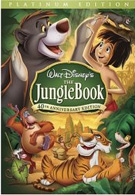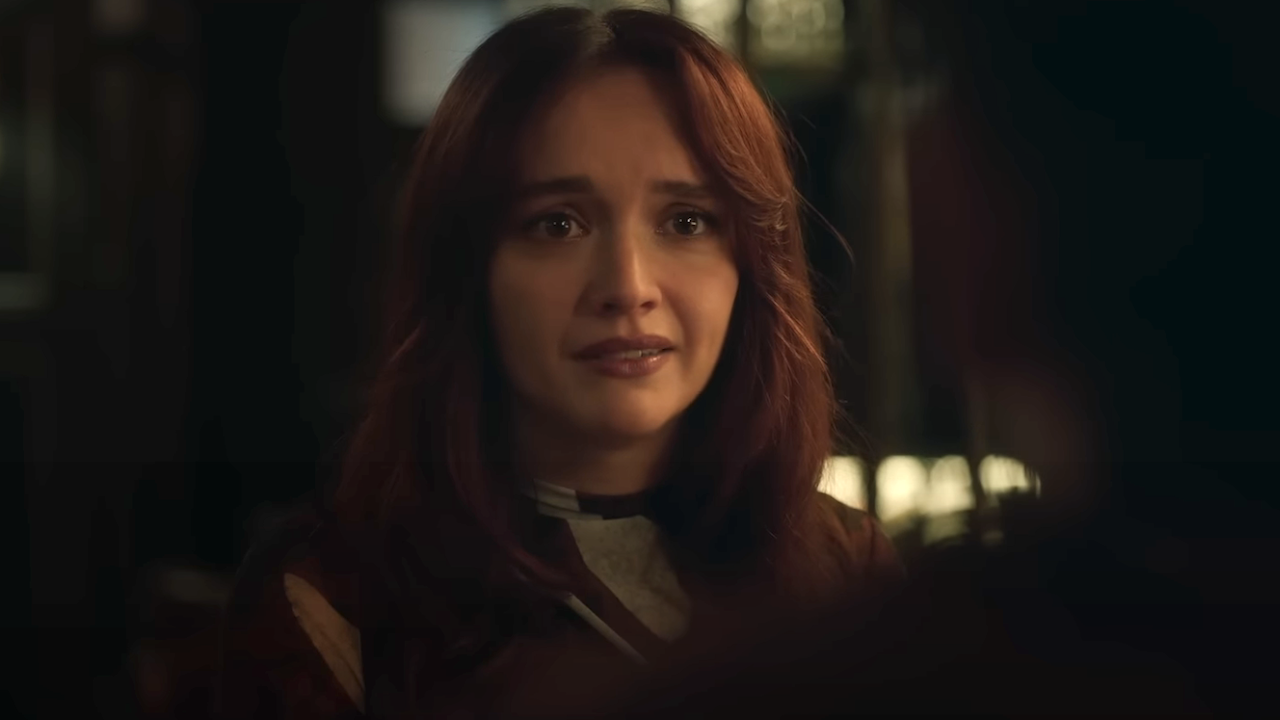Walt Disney had an undeniable impact on animation and storytelling. In many ways his productions set the stage for the entire animation industry, with the effects of his work even visible in today’s films. However, Disney is also responsible for altering his adapted stories to a point where the original story is barely recognizable. This is particularly evident in The Jungle Book, a fun animated tale that is quite a departure from Rudyard Kipling’s darker stories, which supplied the source material. But, this is Disney, and we’ve just come to accept that the name means lighthearted fun with strong characters, without paying much attention to the fact that more people know Mowgli, Baloo, and Bagheera as they appear in their animated incarnations than in their original narrative. At its heart, The Jungle Book is probably the simplest of Disney’s animated stories. Bagheera the panther finds an orphaned baby (or “man-cub”) in the jungle and takes the child, Mowgli, to the wolves, who adopt him. Ten years later, word comes that Shere Khan the tiger has returned to the wolves' area of the jungle and will be coming for the man-cub. Bagheera takes responsibility for leading Mowgli back to the man-village to live in the safety of his own kind. Along the way, the panther and boy encounter Baloo the bear, Colonel Hathi the elephant, Kaa the snake, and King Louie the orangutan, among others, each of which create interesting encounters for the boy who wants to remain in the wild of the jungle.
Like most of the movies under Walt Disney’s personal watch, the complexity of the movie doesn’t come from the story, but rather the characters themselves. Walt believed that strong characters made for a strong movie (a philosophy that Pixar has finally started to return to the house-that-Walt-built) and that appears prominently in The Jungle Book. You have the conflict between the carefree lifestyle of Baloo and the more reserved and focused personality of Bagheera. There’s the difference between the boy who wants to stay in the wild and the caretaker who knows it’s in the boy’s best interest to leave, and then add in the bear-friend who wants the kid’s companionship for even more complexity. It all comes from the characters though, as the story’s basic conflicts are so simple they are almost unnecessary. The story’s antagonist barely even appears until the last quarter of a very short film because, other than being the reason for Mowgli needing to leave, there’s not a high demand for him to be there.
Watching The Jungle Book today, forty years after it was originally released, I can’t help but wonder if the story is too simple, however. Kids who are used to keeping up with plots of more modern Disney favorites like Lilo & Stitch might get bored by the lack of storylines to contend with. Of course, there are always other aspects of the film to enjoy, such as the memorable tunes “The Bare Necessities” and “I Wanna Be Like You” – tunes that are sadly absent from Disney’s modern day releases.
While the story may be less complicated, there’s no denying The Jungle Book has been a strong inspiration on the Disney animated pictures that have come since. If nothing else, the movie immediately draws the more recent Tarzan to mind, which obviously borrowed heavily from Walt’s creation for its character design and style. If for that reason alone, it’s worth revisiting The Jungle Book just to know your Disney history and see how Walt Disney could take “the bare necessities” and create an entertaining picture. One of my common complaints about Disney DVDs is the absolute focus a lot of them tend to have towards children. I get that animated Disney flicks tend to be seen as kids movies, but let’s be honest – these are movies that have been around for generations. Shouldn’t there be some loving for the older fans as well? With the 40th Anniversary “Platinum” release of The Jungle Book, Disney has managed to hit a perfect balance of fun and games for the kids and nostalgia and information for Disney fans.
The movie is beautifully restored with vibrant images and sound. The images are breathtakingly clear and gorgeous while the music, one of the most important elements of Disney’s classic movie, sounds fantastic. I’ve never had a complaint about a Disney animated transfer and this movie continues that trend.
One of the odd choices on this two-disc set is an “index,” although I must say it’s a choice I really like. The index is just a list of what contents can be found on which disc, so if you’re looking for that really cool featurette on Disney’s conservation efforts you can check and see if you have the right disc in or not. It’s a small thing, especially since there is a paper DVD Guide in the case, but it’s still a nice thing to provide.
Accompanying the movie on Disc One is a commentary track featuring a hodgepodge of perspectives including musician Richard Sherman, animator Andreas Deja, and the voice of Mowgli, Bruce Reitherman. As if those perspectives weren’t enough, the commentary is sprinkled with vintage comments about the movie from people who worked on it like Ollie Johnston, and Frank Armitage. Thank Disney for those audio archives they can tap for commentaries like this. There’s never a moment that passes that something informative isn’t being said. Of course, you lose the spontaneity when it’s edited together like this, but the information is incredible.
Your Daily Blend of Entertainment News
“The Lost Character: Rocky the Rhino” gets his own brief featurette, explaining the background of the character and why he was cut, as well as showing what the scene would have been like through the use of storyboards. It also features a more Beatle-like performance of the vulture’s song “That’s What Friends Are For”; appropriate considering their 1967 mop-top hairstyles were an homage to the band.
Disc One also contains a focus on some of the music from the movie, including a chance to jump straight to any song in the film (with the option for lyrics on screen for sing-alongs), deleted music that would be better served on the second disc (more on that in a minute), and a music video from Disney’s latest talent performing “I Wan’na Be Like You.” It’s one of those features that’s better for younger fans of the movie, although the ability to jump straight to a song can be useful after they get stuck in your head.
Disc Two is where the real meat is on this set. There’s a 45-minute “The Making of The Jungle Book” featurette that is an absolute must-see for any fan of classic Disney animation. Not only does the featurette hit on the different duties of the people involved, including lots of high praise for Walt’s famous “Nine Old Men” and specifically Frank and Ollie, but because this was the last animated film Walt was alive for, there is a small amount of time given to remembering his final days of involvement and the reaction to his passing. It’s a very touching look at movie making history, particularly animation movie making, and it’s no surprise to see modern names like Brad Bird included in the discussion of the influence of Walt, his character-driven philosophy, and the influence of The Jungle Book.
One of the really interesting things to come to light in the featurette is how this project changed over time. Walt originally entrusted The Jungle Book to his story-guy Bill Peet. Peet wanted the project to be closer to Kipling’s darker story, which wasn’t to Walt’s liking. The two exchanged words and Peet left the project, creating a rift between the two men that was never resolved. Peet wasn’t the only one who saw the darker side of Kipling’s work. Original musician Terry Gilkyson had a darker sound for the film’s songs that Walt didn’t like. He cut all of Gilkyson’s songs except one (“The Bare Necessities” which Walt was begged by others working on the project to keep) and replaced him with the Sherman Brothers, who had done work on Mary Poppins. Gilkyson’s songs are the deleted music that appears on disc one, but when you first encounter them you don’t know why they are there unless you’re already aware of the story. That’s why I said those would be better served on disc two, although it is a minor complaint.
Several other featurettes are included in the “Man Village” portion of the disc, where the more grown-up goodies can be found. “Disney’s Kipling: Walt’s Magic Touch on a Literary Classic” is a solid look at the differences between storyboards of Peet’s vision of Kipling’s dark Jungle Book tales and the final product realized by Walt’s crew. “The Lure of The Jungle Book” explores some of the influence the picture has had on modern day animators and pictures. Both featurettes are really interesting watches, as is a far-too short discussion by Frank and Ollie on animation.
The other part of Disc Two is “Jungle Fun” which is aimed more at the younger viewers. There are several set-top games to be found here as well as two more educational (but still fun) featurettes about the real life counterparts to the animals in the movie.
The Jungle Book 40th Anniversary Edition is a marvelous release from Disney DVD. While the movie itself may be simple to a fault, the bonus material involved is almost guaranteed to give you a greater appreciation of both the movie and the process behind it. This is a strong addition to the library of any Disney fan.

